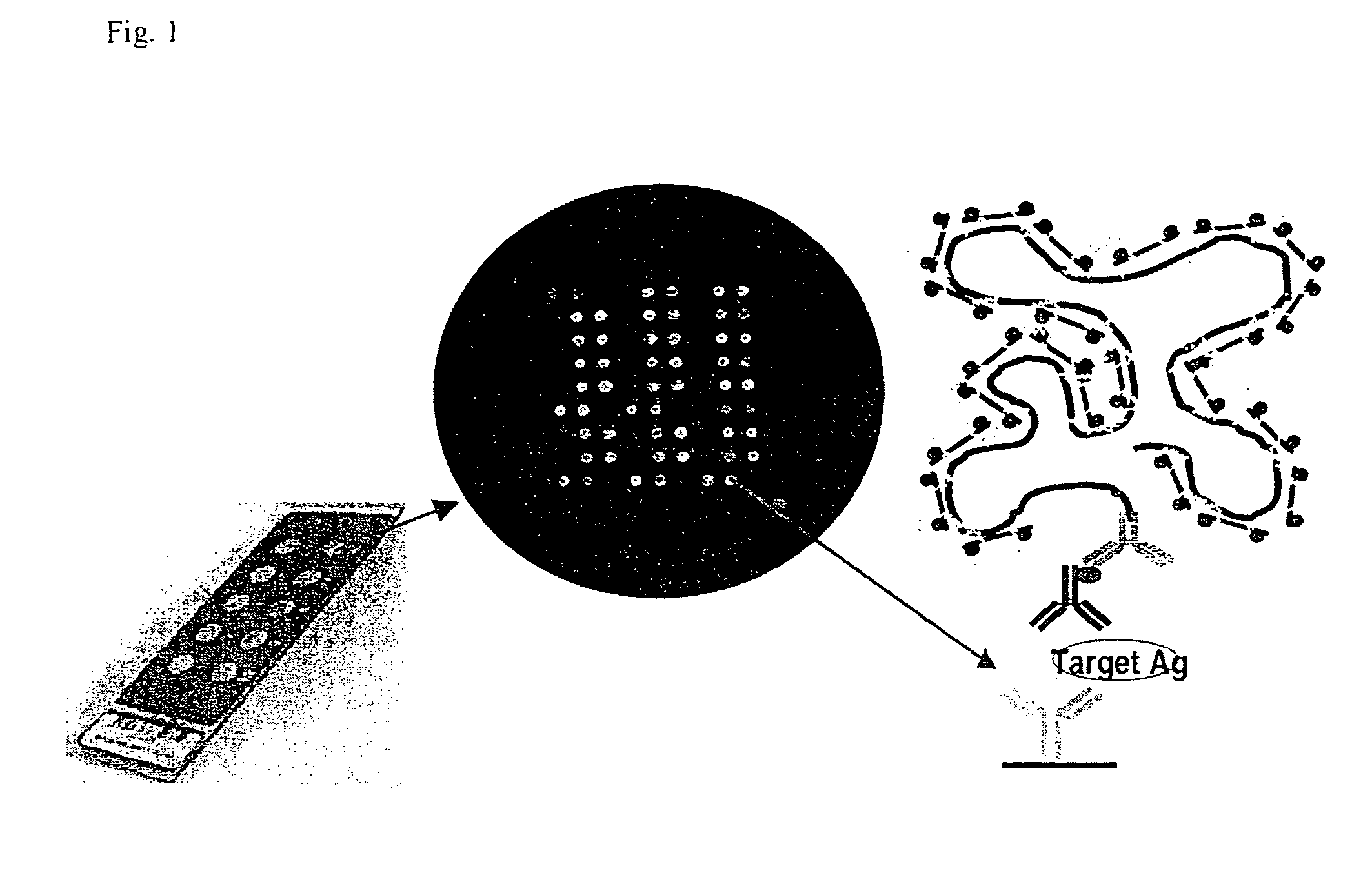Use of cytokines secreted by dendritic cells
a technology of dendritic cells and cytokines, which is applied in the field of dendritic cell use, can solve the problems of not yet demonstrated practical utility of measuring protein expression levels in a manner analogous to a gene expression array, and limited experience with such arrays
- Summary
- Abstract
- Description
- Claims
- Application Information
AI Technical Summary
Problems solved by technology
Method used
Image
Examples
example 1
Experimental Protocol
[0028] Conjugate Synthesis. Mouse monoclonal anti-biotin IgG (Jackson ImmunoResearch Laboratories, Inc.) at a concentration of 5 mg / ml in PBS (phosphate buffered saline) buffer (pH 7.2) with 10 mM EDTA was reduced with 2-mercaptoethylamine (MEA, Pierce Chemical Co.) for 90 min at 37.degree. C. The reduced IgG was purified on a PD10 column (Amersham Pharmacia Biotech, Piscataway, N.J.). A 5'-terminal amine-modified oligonucleotide, 5'-NH.sub.2-AAA AAA AAA AAA AAA CAC AGC TGA GGA TAG GAC AT-3', was treated with N-[.gamma.-maleimidobutyryloxy]sulfo-succinimide ester (sulfo-GMBS, Pierce Chemical Co.) in PBS buffer (pH 7.2). The reaction was incubated for 30 min at 37.degree. C. and then 30 min at room temperature. The maleimide-activated oligo was purified with a PD10 column. Fractions containing modified oligo were collected and concentrated. The derivatized oligo was then conjugated to the reduced IgG (molar ratio of modified oligo to reduced IgG was 10:1) by incu...
example 2
[0032] Antibody Microarrays. Microarrays were printed on thiolsilane-coated and cross-linker activated glass slides divided by Teflon boundaries into sixteen 0.5 cm diameter circular analysis sites (or "subarrays"; FIG. 1). This format minimized reagent consumption, segregated immunoassays into relatively small groups, and allowed different samples to be applied to each. Subarray spacing allowed automated processing by a liquid-handling robot with an 8-pipette tip head. Each microarray slide allowed duplicate measurements of 51 human cytokines in 8 samples. Cytokines representing both inflammatory and homeostatic groups were chosen for analysis, since they represented low abundance proteins whose absolute level was of biological significance (Table 1; 15-18). 150 "features" were printed at known locations in each subarray. 100 of these represented 25 single monoclonal antibodies, each spotted in quadruplicate and each specific for a single cytokine. Remaining features represented in...
example 3
[0036] Application of Antibody Arrays to Langerhans Cell Maturation. Dendritic cells are critical in both initiating and directing the immune response. Dendritic cells (DCs), which include multiple subsets (23), sample and process antigen and then, given the proper environmental cues, mature, migrate and present these antigens to naive T cell populations in draining lymph nodes. The cytokine microarray was used to study factors secreted during maturation of Langerhans cells (LC), a type of DC found in the epidermis of skin, to shed light on LC signals for helper T cell (T.sub.H) maturation. The identification of such cytokines is significant because LCs elaborate numerous cytokines that affect both the development of LCs and lymphocytes in the surrounding area (23-24). Factors secreted by LC at certain stages of differentiation induce naive helper T lymphocytes (T.sub.H0) to differentiate into either T.sub.H1 or T.sub.H2 cells that, in turn, stimulate cellular or humoral immune resp...
PUM
| Property | Measurement | Unit |
|---|---|---|
| Time | aaaaa | aaaaa |
| Time | aaaaa | aaaaa |
| Time | aaaaa | aaaaa |
Abstract
Description
Claims
Application Information
 Login to View More
Login to View More - R&D
- Intellectual Property
- Life Sciences
- Materials
- Tech Scout
- Unparalleled Data Quality
- Higher Quality Content
- 60% Fewer Hallucinations
Browse by: Latest US Patents, China's latest patents, Technical Efficacy Thesaurus, Application Domain, Technology Topic, Popular Technical Reports.
© 2025 PatSnap. All rights reserved.Legal|Privacy policy|Modern Slavery Act Transparency Statement|Sitemap|About US| Contact US: help@patsnap.com



